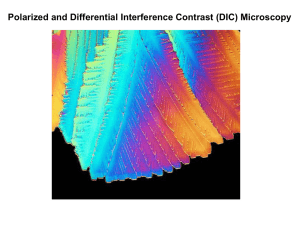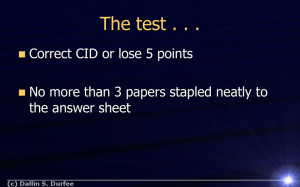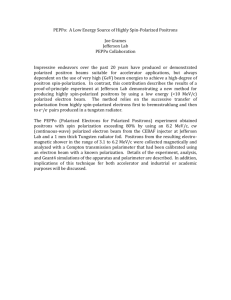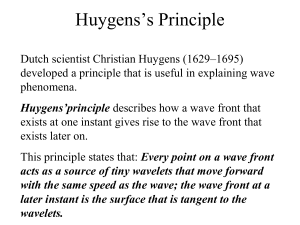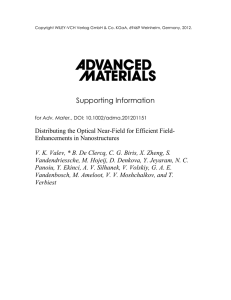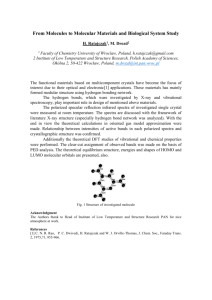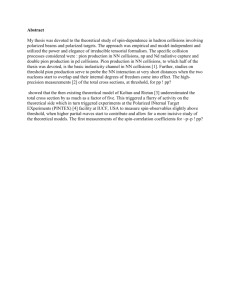Physics MCQ Polarization
advertisement
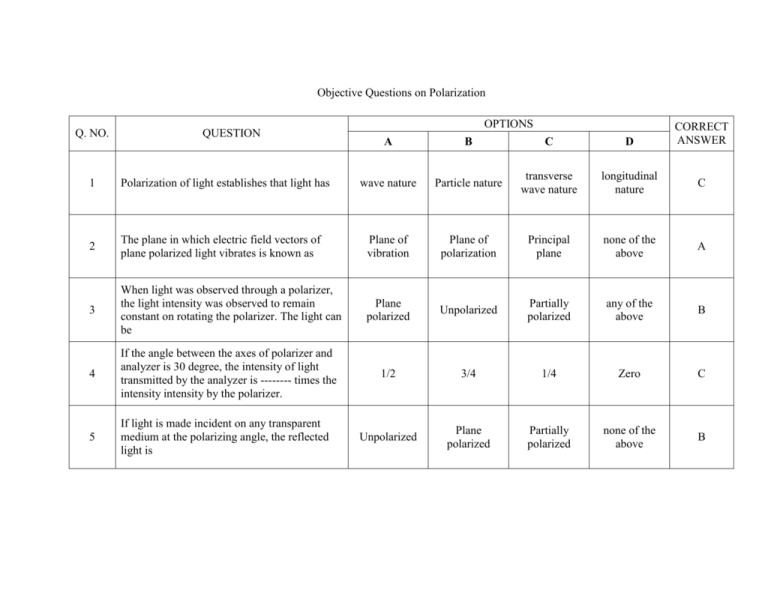
Objective Questions on Polarization Q. NO. QUESTION OPTIONS CORRECT ANSWER A B C D wave nature Particle nature transverse wave nature longitudinal nature C 1 Polarization of light establishes that light has 2 The plane in which electric field vectors of plane polarized light vibrates is known as Plane of vibration Plane of polarization Principal plane none of the above A 3 When light was observed through a polarizer, the light intensity was observed to remain constant on rotating the polarizer. The light can be Plane polarized Unpolarized Partially polarized any of the above B 4 If the angle between the axes of polarizer and analyzer is 30 degree, the intensity of light transmitted by the analyzer is -------- times the intensity intensity by the polarizer. 1/2 3/4 1/4 Zero C 5 If light is made incident on any transparent medium at the polarizing angle, the reflected light is Unpolarized Plane polarized Partially polarized none of the above B 6 If light is made incident on any transparent medium at the polarizing angle, the angle between the reflected ray and the refracted ray is 7 The refractive index of any transparent material is the -------- of its polarising angle 8 When an object is seen through a double refracating medium, if two images are not seen, the light must be travelling ------- 45 degree 90 degree 30 degree 60 degree B sine cosine tangent secant C Parallel to optic axis perpendicular to optic axis Either parallel or perpendicular to optic axis Neither parallel nor perpendicular to optic axis D An imaginary line inside the crystal A real line inside the crystal A direction inside the crystal none of the above C 9 Optic axis is ----- 10 The vibrations of O-ray are ---------- to principal plane at 45 degree parallel perpendicular at any angle C 11 The vibrations of E-ray are ---------- to principal plane at 45 degree parallel perpendicular at any angle B 12 According to Huygen's theory of double refraction, every point in a double refracting medium is a source of ------ type of wave fronts. one two three four B 13 If the light is incident on a transparent material of refractive index √3 and the reflected light is observed to be plane polarized, the angle of incidence is ---- 14 45 degree 90 degree 30 degree 60 degree D The shape of O-wave front is Plane Spherical elliptical cylindrical B 15 The shape of E-wavefront is Plane Spherical elliptical cylindrical C 16 ---- waves travel with same velocity in all direction O E O and E Neither O nor E A 17 ---- waves travel with different velocity in all direction O E O and E Neither O nor E B 18 The velocity of E waves is greater than O waves in all direction except along axis in ---crystal Positive Negative Both positive & negative Neither positive nor negative B 19 The velocity of O waves is greater than E waves in all direction except along axis in ---crystal Positive Negative Both positive & negative Neither positive nor negative A Negative Both positive & negative Neither positive nor negative C μo > μe μo < μe μo = μe none of the above C μo > μe μo < μe μo = μe none of the above C Wavelength of light All the above D 20 The velocity of O waves and E waves is same along optic axis in ---- crystal Positive 21 For positive crystal along optic axis, ---- 22 For negative crystal along optic axis, ---- 23 The path difference introduced by a retardation plate between O and E waves depends upon--- Thickness of the plate Difference in refractive indices of plate for O and E waves 24 A quarter wave plate produces path difference of ---- between O and E waves λ λ/2 λ/4 3λ/4 C 25 A half wave plate produces path difference of --- between O and E waves λ λ/2 λ/4 3λ/4 B 26 If the light is incident on a transparent material of refractive index √3 and the reflected light is observed to be plane polarized, the angle of refraction is ---- 45 degree 90 degree 30 degree 60 degree C 27 For positive crystal, the thickness of quarter wave plate is ----- λ / 4 ( μe - μo) λ / 4 ( μo - μe) λ / 2 ( μe - μo) λ / 2 ( μo - μe) A 28 For positive crystal, the thickness of half wave plate is ----- λ / 4 ( μe - μo) λ / 4 ( μo - μe) λ / 2 ( μe - μo) λ / 2 ( μo - μe) C 29 For negative crystal, the thickness of quarter wave plate is ----- λ / 4 ( μe - μo) λ / 4 ( μo - μe) λ / 2 ( μe - μo) λ / 2 ( μo - μe) B 30 For negative crystal, the thickness of half wave plate is ----- λ / 4 ( μe - μo) λ / 4 ( μo - μe) λ / 2 ( μe - μo) λ / 2 ( μo - μe) D 31 If the angle between the axes of polarizer and analyzer is 120 degree, the intensity of light transmitted by the polarizer is -------- times the intensity intensity by the analyzer. 1/4 3/4 4/3 4 D 32 The property of certain crystals to absorb either the O or the E ray to a larger extent than the other is known as ---- Double refraction Birefringence Polarization Dichroism D 33 The property of rotating the plane of vibration of plane polarized light is known as ---- Double refraction Optical activity Polarization Dichroism B Independent of wavelength Inversely Directly Inversely proportional to proportional to proportional to square of wavelength wavelength wavelength 34 The specific rotation is ----- 35 The thickness of crystal in an LCD is chosen so that it rotates the plane of vibration of plane polarized light by ---- 45 degree 90 degree 30 degree 36 When two plane polarized light waves are followed to superimpose and the resultant electric vector rotates in such a way that its tip traces an ellipse, the resultant light is known as Elliptically polarized light Circularly polarized light 37 When the resultant of two waves of equal amplitudes vibrating at right angles to each other and having a phase difference of /2 produces Elliptically polarized light 38 When the resultant of two waves of unequal amplitudes vibrating at right angles to each other and having a phase difference of /2 produces D 60 degree B Plane polarized light None of the above B Circularly polarized light Plane polarized light None of the above A Elliptically polarized light Circularly polarized light Plane polarized light None of the above A 39 If plane polarized light is passed through a quarter wave plate a phase difference of /2 (path difference of /4) is introduced between O – and E – ray so that the resultant beam means transmitted beam is Elliptically polarized light Circularly polarized light Plane polarized light None of the above A 40 If plane polarized light is passed through a quarter wave plate a phase difference of other than /2 is introduced between O – and E – ray so that the resultant light is Elliptically polarized light Circularly polarized light Plane polarized light None of the above B 41 If plane polarized light is passed through a half wave plate, the plane of vibration of plane polarized light is rotated then emergent light becomes Elliptically polarized light Circularly polarized light Plane polarized light None of the above C 42 Elliptically polarized light after passing through a quarter wave plate becomes Elliptically polarized light Circularly polarized light Plane polarized light None of the above A 43 Huygen explained the phenomenon of double refraction on the basis of Secondary wavelets Dispersion Scattering Interference A O- ray is less than velocity of E – ray in all directions except along the optic axis O- ray and Eray are equal in magnitude in all directions except along the optic axis None of the above A O- ray is less than velocity of E – ray in all directions except along the optic axis O- ray and Eray is equal in magnitude in all directions except along the optic axis None of the above B the O and Ewavefronts travel in same direction with same velocity the O and Ewavefronts None of the travel in above different directions with B 44 45 46 In positive crystal, velocity of In negative crystal, velocity of When optic axis is perpendicular to the crystal surface then O- ray is greater than velocity of E – ray in all directions except along the optic axis O- ray is greater than velocity of E – ray in all directions except along the optic axis the O and Ewavefronts travel in different directions with same velocity 47 48 49 50 different velocity When the optic axis is parallel to the crystal surface then the O and Ewavefronts travel in different directions with same velocity the O and Ewavefronts travel in same direction with same velocity When the optic axis is inclined to the crystal surface then the O and Ewavefronts travel in different directions with same velocity the O and Ewavefronts travel in same direction with same velocity The quarter wave plate produces The half wave plate produces path difference of /4 or phase difference of /2 radians between Oand E-waves path diff. of /4 or phase diff.of /2 the O and Ewavefronts travel in different directions with different velocity the O and Ewavefronts travel in different directions with different velocity None of the above C None of the above A path difference of /4 or phase difference of radians path difference of /2 or phase difference of /2 radians None of the above A path difference of /4 or phase radians between difference of O-and E waves radians path difference of /2 or phase difference of /2 radians None of the above C 51 The thickness of quarter wave plate (for negative crystal) is t = /[4(o e)] t = /[4(e o)] t = /[2(o e)] t = /[2(e o)] A 52 The thickness of quarter wave plate (for positive crystal) is t = /[4(o e)] t = /[4(e o)] t = /[2(o e)] t = /[2(e o)] B Elliptically polarized light Circularly polarized light Plane polarized light None of the above B 30 0 45 0 60 0 00 A 53 54 When two plane polarized light waves are allowed to superimpose and the resultant electric vector rotates in such a way that its tip traces a circle, then the resultant light is known as Plane polarized light is incident on an analyzer. If the intensity of emergent ray falls to three fourth, the angle of axes of the analyzer with respect to plane of vibration of incident polarized beam is 55 To analyze a plane polarized light, an analyzer is rotated. In one complete rotation of the analyzer the following observation occurs one complete extinction one brightness and two times total darkness two times brightness and one time darkness two times brightness and two times darkness D 56 An unpolarized beam of intensity 2a2 passes through a Polaroid. The intensity of emergent plane polarized light is a2 2a2 2 a2 a2/2 A 57 A calcite crystal is placed over a dot on piece of paper and rotated. On seeing through a calcite one finds one dot two dots which are stationary one dot rotating about the other two rotating dots C 58 In a doubly refracting crystals along optic axis 59 The axes of two Nicol prisms are parallel to each other; one of the two Nicols is rotated through 600. The ratio of intensity of transmitted light before and after rotation is 60 Two PPL beams of equal amplitudes with phase difference /2 are mutually perpendicular. The superposition of two results 61 62 63 A rotating polarizer is placed into the path of a light beam. If the intensity of the transmitted light varies with zero minima twice in one complete rotation, then the incident light will be A rotating polarizer is placed into the path of a light beam. If the intensity of the transmitted light varies with non-zero minima twice in one complete rotation, then the incident light will be o > e o - e 1:2 PPL Plane polarized Plane polarized A rotating polarizer is placed into the path of a light beam. If the intensity of the transmitted Plane light remains constant in one complete rotation, polarized then the incident light will be o < e 2:1 CPL Either elliptically polarized or partially polarized Either elliptically polarized or partially polarized Either elliptically polarized or partially polarized 4:1 o - e2 1: 4 B C EPL Par PL B Either circularly polarized or unpolarized None of these A Either circularly polarized or unpolarized None of these D Either circularly polarized or unpolarized None of these B 64 Which of the following statement is correct? plane polarized light and elliptically polarized light are the special cases of circularly polarized light 65 The optically active substances, which rotate the plane of polarization in clockwise direction, are known as dextro rotatory or right- handed substance elliptically polarized light and circularly polarized light are the special cases of plane polarized light plane polarized light and circularly polarized light are the special cases of elliptically polarized light None of these B dextro rotatory or left- handed substance laevo rotatory or right- handed substance laevo rotatory or left- handed substance B
